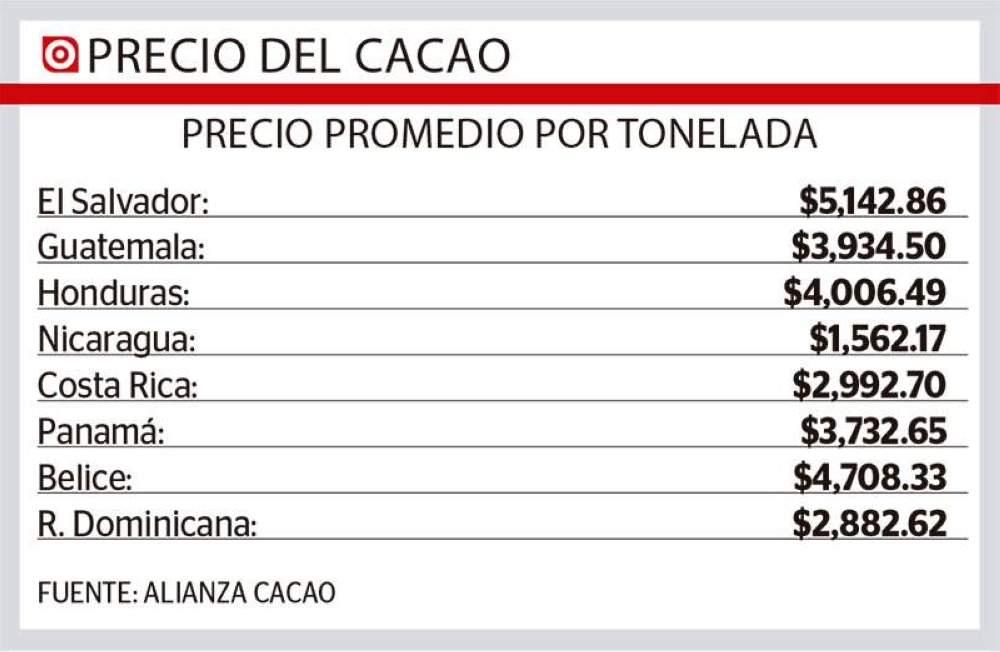Europe is the main buyer of Salvadoran cocoa.
The high quality of Salvadoran cocoa have caused the grain to be placed as the best paid in Central America, above $5,000 a ton, according to data from the Cocoa Alliance.
Jairo Andrade, director of the program, stressed that Salvadoran cocoa has gained prestige in the specialized segment, despite the fact that its export share is low.
The problem is not to get a market, but volume, he said.
On average, one ton of Salvadoran cocoa is exported at $5,142.86, the best figure in the SICA region (Central America and Dominican Republic). The second-highest value is in Belize, at $4,708.33 a tonne, and Honduras at $4,006.49.
Guatemala sells on average at $3,934.5 a tonne of cocoa, Costa Rica at $2,992.7, Panama at $3,732.6, the Dominican Republic at $2,882.6 and Nicaragua at $1,562.17.
According to the data collected by the Alliance, El Salvador exports a little more than $5.8 million in cocoa and derived products, a figure that only exceeds Belize’s $1.01 million or $1.2 million from Honduras.
The big exporters in the region are the Dominican Republic with $218 million and Guatemala with $15.9 million, followed by Costa Rica with $12.3 million.
Price on the rise
Salvadoran cocoa was even sold above the average quoted on the New York Stock Exchange, which in recent weeks broke record six decades as the risk of deficits is expanding due to the fall in production in the countries of the West African, the world’s big suppliers, due to heavy rains in the last two years.
Cocoa futures were listed on the stock market at more than $2,700 a tonne, a value that stuck to more than $6,000 in early February.
The Salvadoran producer was receiving more than double the reference price of the New York Stock Exchange. This was very good, said Andrade, who considered that with the rebound in the market you cannot talk about an additional benefit for local cocoa growers because the main destination of the harvest is domestic consumption.

DEM
Of the more than 1,200 tonnes obtained in the 2022-2023 cycle, at least 30 tonnes were destined for Europe, the main buyer.
In El Salvador there is a culture of high cocoa consumption. “Then, if the domestic market is the main destination of domestic production, there we have a problem,” he added. If the final consumer was paying $1 for a bag or chocolate tablet, it can hardly go on the market at $2. The demand for cocoa itself in the domestic market will also be restricted if prices rise in this magnitude – he added.
Similar situation will occur in the value of exports, he warned, because it is not as elastic – consumers’ purchasing capacity. The increase in cocoa prices that is exported is going to happen, but not in the amounts of the international market because it is not to pay those prices, he said.
Impact of El Niño.
In addition, the market has an impact on crop disruptions in Latin America due to the El Niño climate phenomenon, associated with periods of drought followed by heavy rainfall.
In the case of El Salvador, Andrade detailed that the rains of Storm Julia in October 2023 caused the plants to abort the flowers, so the cocoa year that was due to begin between April and May 2024 will be delayed, although it estimates that production will remain above 1,300 tons.
Ancient Grain
Cocoa cultivation is considered ancestral, but the areas were reduced with the massification of cannons and basic grains.
1. Zones
The Alliance, a program that began the sector in 2014, records that there are more than 5.00 blocks of young plantations in El Salvador.
2.- Producers
More than 2,000 producers participate in the sector, most of them are coffee growers who grew cocoa due to the fall in the price of aromatic.
3.- Export
Of the 1,200 tonnes in the 2022-2023 cycle, at least 30 were exported to Europe. The BCR reports that $6.2 million was exported to 17 countries in 2023.
This article has been translated from the original which first appeared in Diario El Mundo


